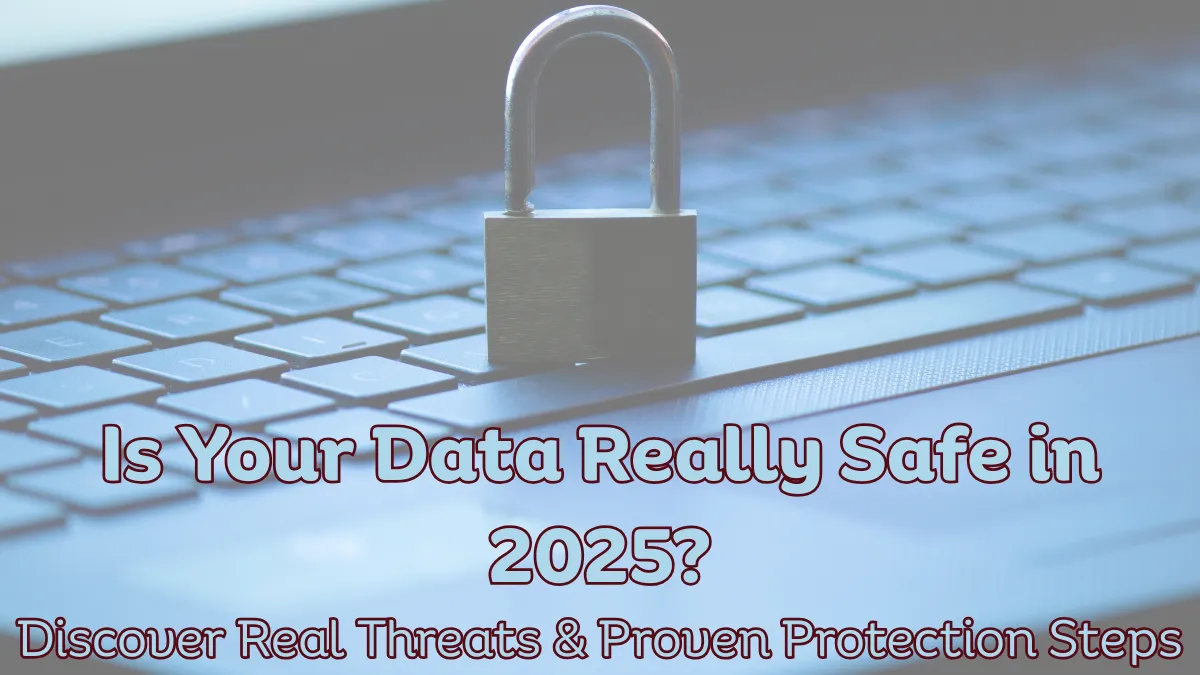Your data is not as safe as you think. In today’s hyper-connected world, your personal information is constantly being collected, shared, and sometimes even sold without your clear consent.
How Safe Is Your Data in 2025? Real Privacy Risks & Protection Tips You Need to Know Now!

Whether you’re browsing social media, using mobile apps, shopping online, or just logging into Wi-Fi, your digital footprint grows—and so do the risks. So, how safe is your data really? Let’s take a deep dive into the world of data privacy, explore real threats, and most importantly, learn how to protect yourself.
What Is Data Privacy and Why Should You Care?
Data privacy refers to your ability to control how your personal information is collected, used, and shared. This includes everything from your name, location, and contact details to your browsing history, shopping habits, and even biometric data.
Why it matters
- Your information can be used to target you with ads, manipulate opinions, or worse—steal your identity.
- Once your data is out there, it’s nearly impossible to get it back.
In short, if you’re connected to the internet, your data privacy is always at risk. That’s why online privacy and digital privacy aren’t just tech buzzwords—they’re essential parts of your everyday safety.
The Truth About Everyday Privacy Threats
The Invisible Risks You Encounter Daily
You may not see it, but your data is constantly being accessed by apps, websites, and devices. These are some common everyday privacy threats:
- Social media tracking: Even if your profile is private, platforms track your behavior.
- Free Wi-Fi networks: Hackers love these. They can intercept your data in seconds.
- Apps with unnecessary permissions: A flashlight app doesn’t need access to your contacts.
- Smart devices (IoT): Your smart fridge, TV, or speaker could be collecting data.
Every interaction you have online leaves digital breadcrumbs. Without strong internet security, these can be collected by bad actors.
Is My Data Safe? Here’s the Real Answer
No, not entirely. Even with precautions, there’s always some level of risk. Major corporations and governments have been breached. If they can be hacked, so can you.
Key statistics
- In 2024 alone, over 1,900 data breaches were reported globally.
- An estimated 80% of consumers have had some form of data exposed.
- The average cost of a data breach is now over $4.5 million.
How safe is your data? It depends on how well you understand the threats and how proactive you are with personal data protection.
Top Online Privacy Risks You Should Know
Phishing Attacks
Emails, texts, and links designed to trick you into giving up passwords or clicking malicious links.
Data Harvesting by Apps
Many free apps make money by collecting and selling your personal data.
Weak Passwords
Using “123456” or the same password across sites makes you a soft target.
Unencrypted Websites
Sites without HTTPS can leak your data during transactions.
Third-party Cookies
These track your browsing habits across websites for targeted advertising.
Knowing these online privacy risks can help you avoid them and increase your cybersecurity awareness.
How to Protect Personal Information Online
Use Strong Passwords
- Mix uppercase, lowercase, symbols, and numbers.
- Don’t reuse passwords.
- Use a password manager.
Enable Two-Factor Authentication (2FA)
Adds an extra layer of online safety beyond just your password.
Be Wary of Public Wi-Fi
Use a VPN when accessing the internet on public networks.
Review App Permissions
Revoke any that seem excessive or unrelated to the app’s function.
Limit Social Media Sharing
Avoid posting sensitive information like your location or travel plans.
These simple data protection tips can go a long way toward boosting your digital data safety.
How Companies Handle Your Data
Most platforms have privacy policies—but they’re often hard to understand and loaded with jargon. In reality, many companies:
- Collect more data than needed.
- Share it with third parties.
- Use it for targeted advertising.
Some even use “dark patterns” to trick you into giving up more data than you intended. Transparency is improving, but privacy in the digital age is still a work in progress.
Mobile Privacy – A Growing Concern
Smartphones are our most personal devices, yet they’re also data goldmines.
Common threats
- Location tracking
- Background data collection
- Microphone and camera access
How to protect your mobile privacy
- Turn off location when not needed.
- Use privacy-focused browsers and apps.
- Check what permissions each app has and remove unnecessary ones.
Your phone knows more about you than you think. Keeping it secure is key to maintaining your online data security.
Kids and Online Privacy
Children are online younger than ever. But they’re also vulnerable.
Risks
- Tracking cookies on educational apps
- In-app purchases without consent
- Social engineering and scams
Parental Actions
- Use parental control software
- Educate kids on privacy basics
- Monitor their digital activity
Protecting your child’s personal data is just as important as your own.
Best Cybersecurity Tips for Everyday Use
Keep Your Devices Updated
Updates fix security holes hackers love.
Use Antivirus Software
It’s a first line of defense against malware.
Don’t Click Suspicious Links
Even if they come from someone you know.
Backup Your Data
Ransomware is real. Always have a backup plan.
Log Out When Done
Especially on shared or public computers.
These cybersecurity tips are basic but powerful ways to protect your digital privacy.
Privacy Protection Laws You Should Know
Governments are stepping up, slowly but surely.
Key Regulations
- GDPR (EU): Strongest consumer data protection law globally.
- CCPA (California): Empowers users to control their data.
- DPDP Bill (India): Recent effort to strengthen data protection.
While laws help, online privacy ultimately comes down to you.
Conclusion: Take Charge of Your Data Today
We live in an age where data is currency—and everyone’s trying to cash in. Whether you’re tech-savvy or just getting started, understanding and improving your online privacy is no longer optional. By being aware of the everyday privacy threats and applying simple data protection tips, you can dramatically improve your digital data safety.
So the next time you ask, “Is my data safe?”, you’ll know exactly how to answer—and act.
FAQs
1. What is the difference between data privacy and data security?
Data privacy is about controlling who accesses your data. Data security is about protecting it from unauthorized access.
2. How can I check if my data has been breached?
Use services like “Have I Been Pwned” to see if your email or passwords have been exposed.
3. Are free VPNs safe?
Most free VPNs sell your data. Opt for reputable, paid options instead.
4. Is incognito mode really private?
No. It only prevents local history saving. Your ISP and visited websites can still track you.
5. Should I worry about smart home devices?
Yes. Many collect and send data to manufacturers. Always read their privacy policies.
6. What are the signs of a phishing email?
Generic greetings, misspellings, urgent language, and unknown senders are red flags.
7. Can social media apps spy on me?
Many access your mic, camera, and location. Always manage app permissions.
8. How often should I update my passwords?
Every 3-6 months. And never reuse them across platforms.








